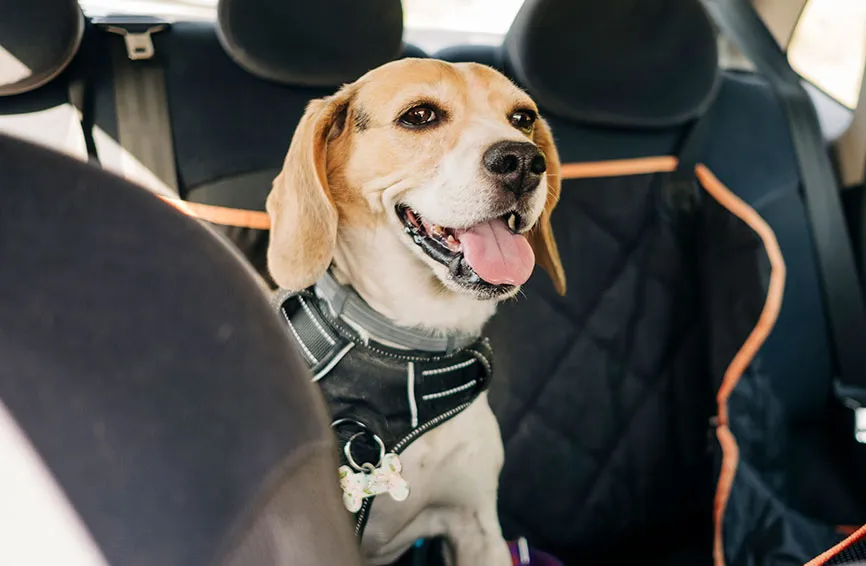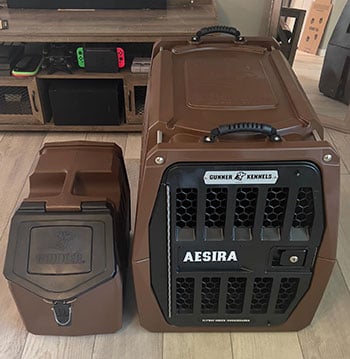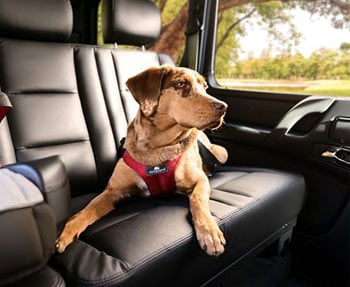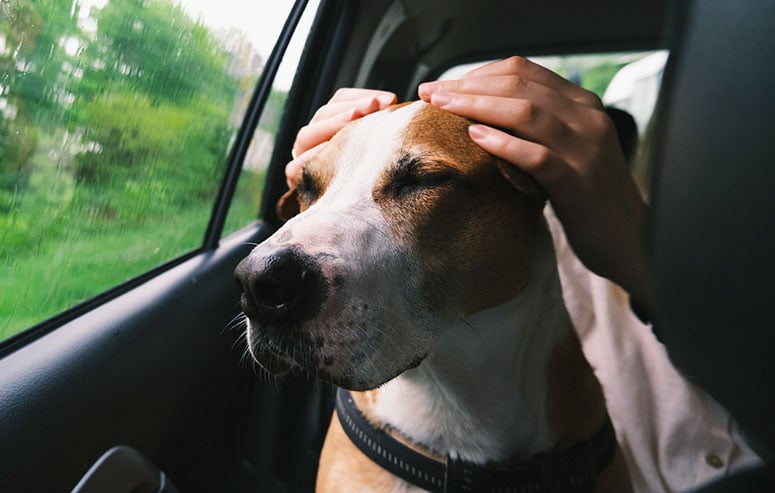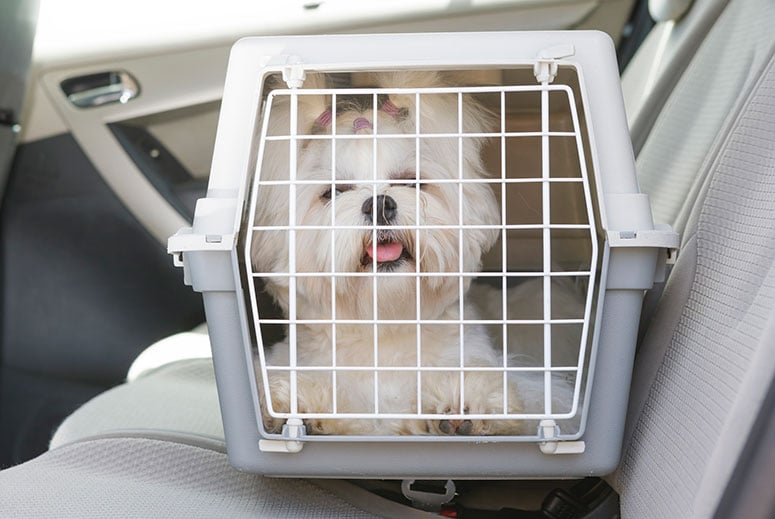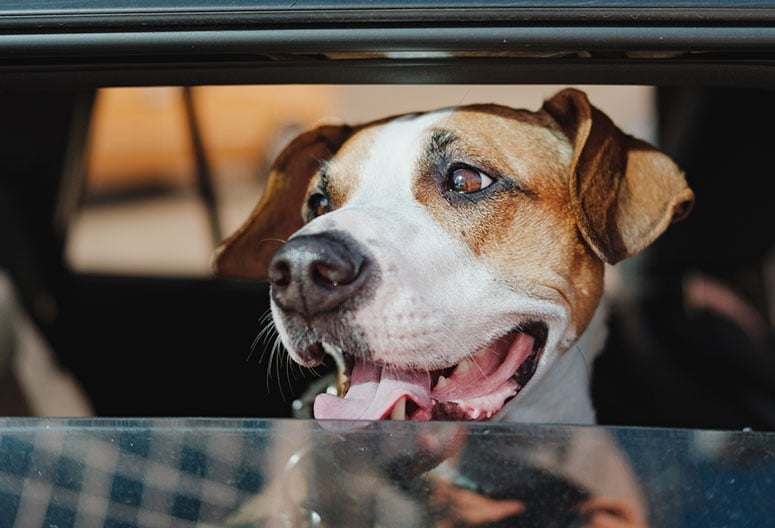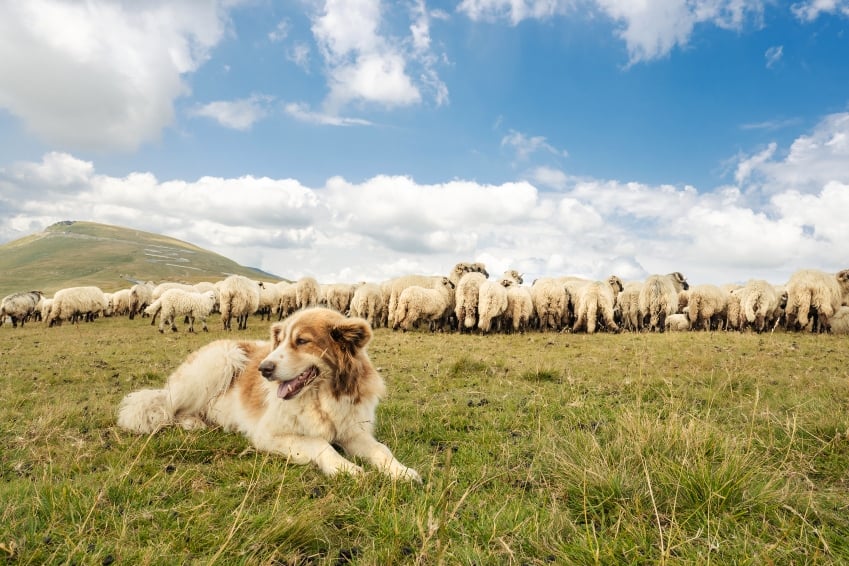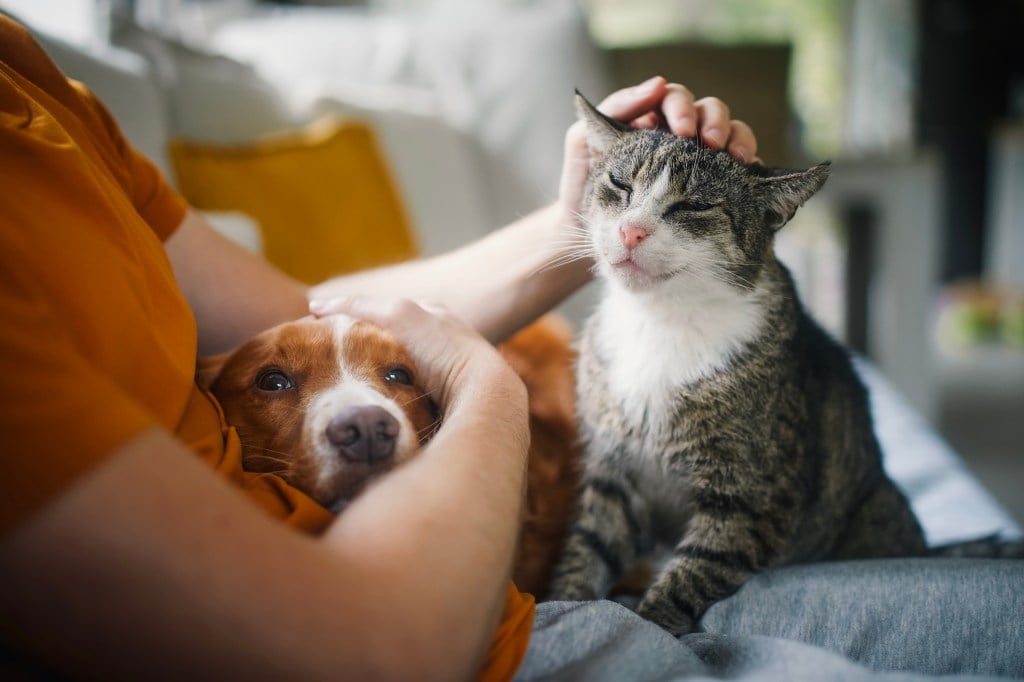Key Takeaways
- Many dogs love car rides, but it may be anxiety-inducing for others. You can take some steps to get your dog comfortable in the car.
- Your dog should always be secured by a crate or harness that has been tested for crash safety.
- If your dog fears the car, you can slowly desensitize them by introducing them slowly.
- If you are planning a road trip with your dog, start preparing them weeks in advance.
Table of Contents
Whether you take your dog everywhere or only when needed, such as going to the vet, your dog will probably spend some time in your car. Many dogs love car rides, but it may be anxiety-inducing for others. This is especially common in rescue dogs who may have suffered some trauma.
For dogs who don’t love the car ride, here are some tips to help them get comfortable.
Using a crate or harness
When dogs are in the car, you should restrain them for their safety and yours. Just as people wear seatbelts, dogs need to be secured. If a vehicle is involved in a crash or brakes abruptly, an unrestrained dog of any size can hurtle through the car, hurting not only themselves but also other passengers. According to the pet advocacy group BarkBuckleUp, a ten-pound dog exerts 500 pounds of force during a 50-mile-per-hour collision in a car. Loose dogs also create a distraction for the driver.
A few years ago, a Healthy Paws customer was struck by another vehicle in Alaska and his unsecured Labrador flew into the windshield and became paralyzed. With the help of Healthy Paws pet insurance, the pet parent got his dog into surgery quickly, and after a long, slow rehabilitation, his dog mostly recovered his movement.
According to another study by Volvo Car USA and The Harris Poll, dogs and people are more stressed when a dog is unrestrained in a car. Researchers found that heart rates increased for people and pets when the dog was not safely secured.
You can safely restrain your dog in two ways – either with a harness designed for car rides or a crate. Which you choose will depend on the size of your pet, whether they are comfortable in a crate and cost. Many crates and car harnesses sold have not been safety checked – or have failed crash tests – so it’s essential to research the best option for your pup. The Center For Pet Safety does detailed testing and rates products for safety.
What makes a safe crate?
In a crash, pet crates and carriers must contain the dog and prevent the animal from becoming a projectile and suffering serious injuries. It is also crucial for the crate to remain fully secured at the connection points. If a pet is unrestrained or the container’s structural integrity fails, the dog can strike and injure a human passenger. A study by the CPS and Subaru in 2015 found some crates completely failed safety testing.
If you are unsure of the crate’s strength, the safety group recommends placing the crate behind the front seats rather than strapping it down. If the crate is not solid enough, the straps could crush it.
Here are a few crate brands that received a 5-star rating in safety testing:
- Sleepypod ($225) offers a carrier/bed for small dogs and cats that is certified as safe and comes with Velcro positioning points to secure seatbelt straps when used as a car seat. It contains a removable, ultra-plush interior bedding.
- The Gunnar G1 Kennel ($550) is essentially “bomb-proof” and can withstand 4,000 lbs. of force, according to the manufacturer; it also excelled in the safety testing by the independent CPS. Four anchor straps secure it to the connection points. It’s also designed with materials that keep it 12% cooler than other kennels, they claim. It comes in a variety of sizes.
- The Cabelas Gun Dog Kennel ($350) received a 5-star rating for its rugged construction, tie-down strap kit, and safety bar. It also includes a stainless steel door, side ventilation slots, and drain holes. It only comes in an intermediate size.
What makes a safe harness?
A few pet harnesses come with crash protection, while others are designed only to secure your pet. To be certified by the CPS, the test dog dummy must remain on the seat, and the harness hardware, webbing and connection points hold solidly in a collision. The safety group says that extension tethers on harnesses increase the risk of injury. The only safety harnesses the CPS has certified are from Sleepypod.
Here are a few harnesses that passed safety testing:
- Sleepypod Clickit Sport ($103) or Sleepypod Clickit Terrain Plus ($126) both have three points of contact to reduce forward and lateral movement in the event of a collision or sudden stop. The webbing design uses a broad, padded vest to distribute and reduce forces that can cause injury. During the testing, the test dog dummy stayed secured in the seat. The harness can be used as a walking harness when not used in the car and includes reflective strips for better visibility. It comes in a variety of sizes.
- While the Kurgo Tru-Fit Enhanced Strength Dog Harness ($40) did not pass CPS’s safety test in 2013 and has not been retested since, the manufacturer says it has made significant improvements and says it has been crash test certified by Calspan, which maintains federal standards for child seats. It includes five points of contact, steel hardware, a broad, padded chest plate and a seatbelt tether compatible with all car seatbelts.
Getting your pup in and out of the vehicle
Some dogs are nervous about jumping in or out of the car, especially if they must launch themselves higher than they feel confident or are physically comfortable with. Jumping out of the vehicle can also be hard on their body with the impact of hitting the ground. If done repeatedly throughout their lifetime, it can lead to joint issues and arthritis as they age. Older dogs should not be allowed to jump out of the car.
If your dog is small, you may be able to lift them into the car. A sturdy ramp, wide with a gradual incline and good traction, can make the process easy for bigger dogs.
If your dog can’t manage a ramp, buying some soft foam stairs is another great option. Instead of having a hard step to navigate, they are designed with curved steps to help your dog easily get up and down. These work well for small dogs, senior dogs, and dogs who feel nervous on unfamiliar surfaces, as the texture is carpet-like.
Try to ensure that the entire experience associated with the car ride is positive. If they are already stressed from trying to jump into the car, it will be harder for them to settle during the drive.
How to get a new dog used to the car
If you have a newly adopted dog or a puppy, it can take time to help them learn to feel comfortable riding in a vehicle.
Here are step-by-step instructions on getting a dog comfortable in the car. Below are more details for different types of dogs:
- To help your dog cope with anxiety they may have about the ride, you need to desensitize them to the experience and associate the car with only good things.
- One way to make positive associations is to scatter treats around the car while it is securely parked and let your dog find the treats. If your dog won’t get in the car, start by scattering treats around outside and work your way to inside the car.
- Once your dog is getting in the car willingly, sit in there with them and close the doors. After he’s done, open the door and get out.
- If your dog is now relaxed in the car, turn the engine on without moving the car.
- Repeat step 4, but give your dog a healthy chew to occupy them. Chewing releases serotonin, a happy hormone.
- Once your dog is busy with the chew, start moving the car slowly. Initially, just backing out of a driveway, then working your way up to longer rides.
Teaching a rescue or traumatized dog to ride in the car
Many rescue dogs were transported in vehicles under conditions that made them feel afraid and stressed. Keep this in mind if your newly adopted dog seems anxious on a car ride, as it may not just be the experience of traveling but their expectation of being taken to yet another home, which triggers fear and abandonment.
For homeless dogs who were fending for themselves, their experience of being captured, then loaded into a vehicle, put in a crate, and taken to a shelter, is very traumatic. This trauma could be triggered every time you take them on a car ride until they have been in your home for weeks or months.
Ask questions of the adoption organization
When you adopt from a rescue or shelter ask the staff or volunteers if yournew family member is comfortable being in a crate, how they have been transported, and how they reacted to the experience. The more information you have, the better decision you can make regarding how to best avoid triggers. As many rescue dogs don’t have a good association with a crate, you may need a seat belt harness to take them home.
Keep your dog company during the trip
Have a family member or friend, someone the dog already feels safe with, sit beside the crated or seat-belted pup in the back. Soothing affection, and a kind, soft tone of voice can be comforting to a dog who has been living in a stressful environment at a shelter.
Keep items of comfort available
If your new pet had a toy, blanket, or dog bed in the shelter or foster home, ask to take them with you. Anything familiar will help your dog feel more comfortable, even if the blanket or bed is ripped, don’t throw it out, as it may be the only ‘security blanket’ your new pup has known.
Teaching a puppy to ride in the car
When taking a puppy home from the breeder, remember that it’s probably their first experience in a moving vehicle. For puppies in a shelter, they have traveled in a vehicle at least once, but riding in a car can be scary the first few times, even if it’s a good experience because it’s unfamiliar.
Not understanding how to deal with the sensations of being in a moving vehicle can cause anxiety; some puppies may even feel nauseous and vomit.
Use a crate
Putting your puppy in a crate is best, as it represents a cozy den. Someone can sit beside the crate and give affection so the puppy doesn’t feel alone.
If you expect to bring a puppy home in a few weeks, ask the breeder to start working with your puppy on crate training, as this will help them feel less stressed on the drive.
Include comfort items
Wrapping your puppy in a blanket that smells like its mom and siblings will help them relax and feel comforted. A cuddly toy can be soothing to a puppy on the drive home and during the first few weeks. Remember that they are used to being snuggled up next to their siblings, and it will feel strange, unfamiliar, and possibly unsettling to sleep alone for a while.
Some ways to comfort all dogs in the car
Calm energy and emotions
Try to keep the energy in the car and your emotions calm and relaxed, as dogs sense and respond to our emotions.
Pheromone plug-in
Purchasing a pheromone plug-in can benefit both puppies and adult dogs in helping them feel safe, as they will feel additional comfort from the pheromones they are used to smelling from their mother.
Essential oils
Some essential oils can help dogs relax. You should make sure your dog likes the smell before using a scent. Some essential oils harm dogs, so purchase them from an educated consultant. The most common essential oil used to help dogs relax that is safe is lavender. Put one drop of lavender and a tablespoon of organic coconut or olive oil in the palm of your hand, then rub your hands together to mix the oils, and rub the mixture onto their dog bed or blanket. Another option is to use a car diffuser with essential oils.
A bone or chew
Having a bone available is beneficial because dogs chew to destress. It can also add a fun element to the car ride and a distraction from outside stimuli.
Watch your speed
Dogs can experience motion sickness, so don’t speed or take corners too fast. Dogs usually feel more comfortable with shorter, lower-speed drives until they get used to the experience of riding in a car. Some dogs enjoy having the windows cracked to sniff the air, while others may feel stressed smelling the strange odors. The only way to find out how your pup responds is to roll the window down a little; always make sure that it’s not too far, as some dogs may try to jump out the window. Don’t let your pup put their head out the window. As cute as it is, it can result in debris hitting your dog, resulting in eye, ear, and head injuries.
Preparation for a long car ride
If you have plans to go on a road trip with your pup for the first time, take a few months to prepare them.
Riding in a crate
- It’s best to position the crate so that your dog can see you, and covering the top, back, and sides of the crate can help them feel more relaxed and settle faster. The less they can see, the less they get triggered by potential threats, and the safer they will feel.
- If they are crate trained, put a crate in the car for them, ask them to get in their crate, then sit in the car beside the crate. Refrain from acknowledging them as they hang out in the crate, and refer to the crate training post if they seem unhappy.
- Once they seem calm being in the crate in your vehicle, start taking short trips around the block for five minutes, one person driving while someone else is sitting in the car close to the crate, for comfort.
- After a few days or weeks, depending on your pup’s comfort level, gradually extend the time in the car.
- Once they are comfortable with longer car rides, have both people sit in the front seats, leaving your dog in the crate.
- Try to drive in different areas, downtown, and out on country roads whenever possible. Each environment will have its own challenges for dogs. In town, dogs can get stressed seeing pedestrians at stoplights. If you need to stop and someone is standing close to the car, many dogs will bark because your car is an extension of your home, and they are trying to protect you. This is where a crate is most beneficial.
Using a harness
- Similar to the crate, get your dog accustomed to using a harness in the car on short jaunts before you take them on a long trip.
- Initially, have someone sit next to them with the harness on for comfort. After they are more relaxed, they can ride alone.
- Make sure the harness fits snugly, but not tight and is secured to a seatbelt or other solid object, according to the harness makers instructions.
Additional tips on car rides with dogs
Motion Sickness
For dogs with motion sickness, wait until you arrive at your destination to feed them or give them breakfast or dinner several hours earlier than usual. Check out this blog post on how to avoid car sickness.
Exercise your dog beforehand
Ensure that your dog has a good walk, game of fetch, or a form of exercise that they enjoy and helps them to release pent-up energy, so they can feel more physically relaxed on the journey.
Allow time for potty breaks
On a long trip, plan to stop every hour or two to make sure your dog can relieve themselves. The break from driving will also relax them.
Be aware of temperature
During the summer months, keeping your pets cool and ensuring good air flow during the ride is crucial. Taking your dog for a car ride early in the morning or as it cools down in the evening are the best times in warmer months. However, check for freezing temperatures and road conditions during the cold winter months before heading out. Traveling during daylight hours is always safest, keeping in mind if the roads are icy and you skid, it could cause severe trauma or potential injury for your dog, and it could take them months to feel safe riding in the car again.
How a veterinarian can help with highly stressed dogs
Stressed dogs riding in the car may need some medication at first to help them relax. It’s going to take time to help them learn to feel safe in the car, and taking the edge off so that they aren’t panting, pacing, and anxious for the entire trip is helpful. Talk to your vet about medication options if your dog is highly anxious in the car. However, try the new medication before your trip. Give them a dose when they are in the comfort and safety of their home, at least a week or so before your trip, to see how they respond.
Every dog reacts differently to medications, and the last thing you want to do is give them something that will make them feel more anxious as you begin a road trip. When trying a new medication, give it to your dog somewhere they don’t already feel nervous so they have the comfort of familiar things around them in case they don’t respond well. Also, ensure you will be home with them for several hours if they need your support. If it isn’t effective, you have time to return to the vet and find another option.
